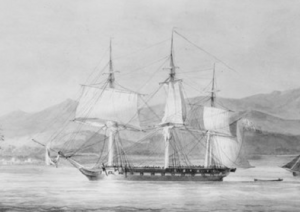HMS Minerva (1805) facts for kids

HMS Minerva off Finisterre Bay, 22 June 1806
|
|
Quick facts for kids History |
|
|---|---|
| Name | HMS Minerva |
| Ordered | 12 July 1804 |
| Builder | Deptford Dockyard |
| Cost | £15,017 |
| Laid down | August 1804 |
| Launched | 25 October 1805 |
| Commissioned | November 1805 |
| Fate | Broken up February 1815 |
| General characteristics | |
| Class and type | 32-gun fifth rate Thames-class frigate |
| Tons burthen | 659 bm |
| Length |
|
| Beam | 34 ft 0.5 in (10.376 m) |
| Depth of hold | 11 ft 3.5 in (3.442 m) |
| Complement | 220 |
| Armament |
|
HMS Minerva was a warship of the Royal Navy, built in 1805. She was a 32-gun frigate, a type of fast sailing ship used for scouting and fighting. Her name came from Minerva, a Roman goddess. She was built at Deptford Dockyard in England. Because of a shortage of building materials during wartime, Minerva was built using an older design. This made her smaller than many other frigates of her time.
Adventures at Sea: Minerva's Service History
Early Missions in the English Channel
In February 1806, Minerva began her service under Captain George Collier. She patrolled the English Channel, which is the sea between England and France. On April 27, Minerva and another ship, HMS Conflict, captured a Spanish privateer called La Finisterre. A privateer was a private ship allowed by a government to attack enemy ships during wartime.
Coastal Operations and Captures
Minerva was very active along the coast. On June 22, her crew attacked an 8-gun fort and captured five Spanish coasters. These were small ships used for trading along the coast. For this brave action, her First Lieutenant, William Mulcaster, received a special sword. A few weeks later, on July 11, Minerva's small boat, called a barge, chased and captured a Spanish lugger named La Buena Dicha. A lugger is a small boat with a special type of sail.
More Captures and Reconnaissance
On October 29, Minerva was scouting near Pontevedra in Spain. She managed to capture two chasse marées from Portonovo. These were another type of small coastal trading vessel. Two days later, her barge captured a Spanish lugger that had sailed from Avilés. Captain Collier also led his crew in a small boat attack, capturing a Spanish gunboat with 30 men on board near Pontevedra.
Working with Other Ships
In February 1807, Minerva teamed up with HMS Amazon. They recaptured the schooner Jackdaw near the Cape Verde islands. Jackdaw had been captured by the enemy just the day before. Later that year, in October, Minerva worked with HMS Naiad and HMS Phoenix. They shared in the prize money from capturing a ship called Vigilante. By the end of 1807, Captain Richard Hawkins took command of Minerva. In March 1808, Minerva captured three Spanish ships: La Purissima Consecion, La Caroline, and another lugger.
Continuing Successes and a Mystery
Minerva kept serving off the coasts of Spain and France. On September 23, 1808, she captured the 8-gun privateer La Joséphine. Sadly, La Joséphine overturned in a storm during the capture, and only 16 of her 50 crew members could be saved. In October 1808, Minerva captured L'Améthyste, which had 14 guns. On April 14, 1809, she captured the Danish brig Edward.
Teamwork and Many Captures
By August 1809, Minerva was near Ushant, an island off the coast of France. She worked with HMS Dreadnought, HMS Gibraltar, HMS Tonnant, and HMS Snapper to capture the Carl Ludwig. Just eight days later, on August 10, she captured another ship, the chasse marée Le Bienfaisant. Minerva continued her successful streak into October. She captured the French ships L'Emerance and L'Emulation on October 3 and 12. Then, on October 20, she captured the chasse marée La Victoire.
Expeditions and Convoy Duties
By December 3, 1810, Minerva was part of a large British expedition. This group, led by Vice-Admiral Sir Albemarle Bertie and Major-General John Abercrombie, successfully captured Isle de France (now Mauritius). On December 28, while with HMS Royal Oak and HMS Valiant, she stopped the ship Mary. In May 1811, Minerva sailed to Newfoundland. From 1812 to 1813, she helped protect convoys, which were groups of merchant ships traveling together, from North America to the West Indies.
The Mystery of L'Artimise
On August 18, 1808, Minerva might have destroyed a French frigate called L'Artimise near Brest. Records show that the crew received "head money" for this action, which was a payment for destroying an enemy ship. Some stories from that time describe British ships chasing L'Artimise ashore. However, there is no clear proof that a French ship named L'Artimise actually existed in the French navy at that time. So, while it's certain that Minerva destroyed a ship by running it aground on that day, the exact identity of that ship remains a mystery.
The End of Minerva's Journey
In 1814, Minerva was placed "in ordinary" at Sheerness Dockyard. This means she was taken out of active service and kept in reserve. In February 1815, she was "broken up" at Sheerness. This means the ship was taken apart, and her materials were reused or scrapped.

